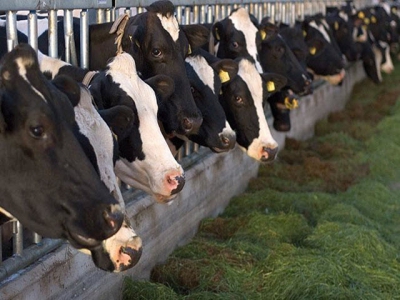Precision dairy rationing tools improve milk production, profits

Maximizing nutrition in early lactation dairy diets can have long-lasting positive effects on production, fertility
Dairy nutritionists who introduce lower spec diets to hedge against high commodity costs or milk price volatility can cause long-lasting effects on a cow’s milk production.
“When you reduce nutrition at the beginning of lactation, you affect the lactation curve in terms of milk regulation,” said Sylvie Andrieu, Cargill’s ruminant technology manager – EMEA. “Nutrition partitioning is really targeted to milk production rather than body tissue reconstitution and it’s why it really has such a profound effect because once you start feeding the cows the right nutrition again, you can’t totally reverse the trajectory.”
Beyond lower milk production, lower nutrient diets can also influence the cow’s reproductive performance and health.
According to a report published in the Journal of Dairy Science, nine studies conducted between 1980 and 2003 suggest the carryover effect of low-spec diets in early lactation can impact milk yield: even after restoring the feeding plan, producers experienced up to 60 percent of the initial milk reduction.
“The longer the feed restriction, the longer the carryover effect was felt,” Andrieu notes. “Even though the farmer may experience lower feed costs up front, it can lower overall farm income.”
The benefits of a high-quality diet will often outweigh any extra costs and will boost the producer’s income-over-feed cost (IOFC), a benchmark for tracking liter-per-cow performance.
Improving income-over-feed costs with precision nutrition
Dairy producers evaluating herd efficiency may choose to rely on precision rationing systems to improve their IOFC.
“Producers want to know how feed additives, for example, can be used to meet a production goal at the best cost,” Andrieu said. “Additives improve rumen fermentation and release more nutrients out of the diet so it’s very important for us to know exactly what response to expect with different additives and circumstances when formulating a diet.”
To do so, a precision modeling system may “meet the cow’s requirements by select limiting digestible amino acids required for milk production and not on nutrients such as crude protein, rumen degradable protein or rumen undegradable protein,” which allows for more accurate diet formulation with a lower crude protein percentage.
“If you take one additive and you know it will improve the digestibility of fiber, it allows you to explore if the producer’s diet needs these additives and predict what the milk response will be, or if the milk production can stay the same, but at a better price,” she says. “But more milk isn’t always the answer. Producers are always looking for ways to manage their income-over-feed costs given the circumstance at the time.”
In one example in the U.K., Andrieu notes Cargill’s DairyMax precision rationing system produced annual savings averaging GBP50 (US$65) per cow.
By taking advantage of precision rationing tools, nutritionists and producers can add value to the ration while improving nutritional values and, ultimately, IOFC.
Có thể bạn quan tâm
 Feeding diseased livestock remains a challenge
Feeding diseased livestock remains a challenge Nutrient requirements for fighting disease are quite different from those required for productive purposes.
 How nutrition influences dairy cow health, immunity
How nutrition influences dairy cow health, immunity Balanced nutrition greatly affects immune function, performance in transition cows
 Forage analysis crucial to accurate ruminant rations
Forage analysis crucial to accurate ruminant rations NIR analysis aids in combating variability, identifying accurate nutrient, mineral parameters